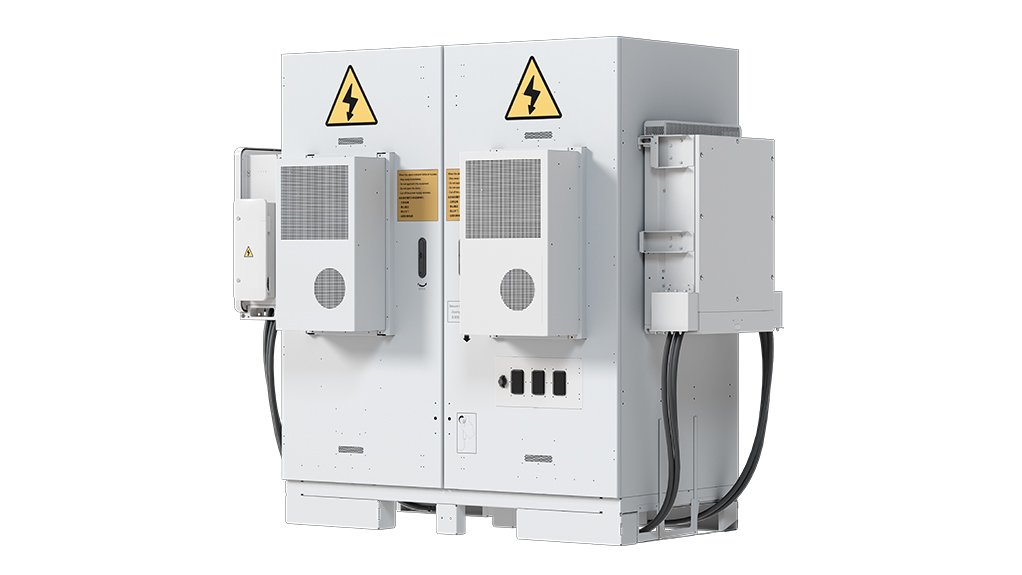A combination of photovoltaic (PV) and battery storage is said to be more effective than diesel-driven generators to supplement energy requirements and prevent production losses as a result of energy disruptions in the mining industry.
Huawei FusionSolar smart PV and energy storage system (ESS) is designed to offer competitive solutions to sub-Saharan African mining operations, considering the rising price of grid-based power and increasing diesel supply constraints and price hikes.
“The FusionSolar product range offers the best containerised solution for utility-scale storage that I’ve seen up to now on the market. Not only is the range reliable and easy to implement, but it also offers attractive efficiencies. The product concept, availability and technical features are brilliant,” says SOLARWORLD Africa MD Gregor Küpper.
SOLARWORLD notes that it became the first company to introduce FusionSolar Smart PV solutions to South Africa in 2014, and now also offers Huawei FusionSolar Smart PV solutions such as the LUNA2000 smart string ESS.
Equipped with lithium-ion batteries, the LUNA2000 is described as a compact, space-optimised solution in a 20-foot container that provides 2 MWh storage capacity. Generation capability can be increased in 200 kW increments following a minimum 1 MW installed capacity, said to offer the same energy storage capacity as the 40-foot containerised solution supplied by its competitors.
FusionSolar regional manager Quintin Zeeman says: “While reducing the cost of performing general maintenance, this feature also saves the cost of having a technician travel to site to conduct that maintenance.” He further emphasises that by optimising its artificial intelligence (AI) technology, Huawei aims to eliminate unnecessary costs for its partners.
“SOLARWORLD just made the latest version available. We went from a 0.5C battery C-rate, which is equal to a 120-minute charge and discharge rate, to a 1C battery C-rate, which is equal to 60 minutes. Many projects that are under development are now reconsidering the use of 1C-rated batteries,” says Küpper.
To ensure the longevity of its batteries, the LUNA2000 employs a temperature controlled environment to prevent battery degradation when operating in hot operating conditions. It is also designed to ensure that the entire capacity of the 2 MWh storage container is not lost while a battery pack is being replaced.
Küpper adds that another important aspect to consider when investing in an ESS is whether the inverter, battery and management system come from the same source, saying that performance issues with small- and large-scale storage systems can arise when combining products from different brands.
Equipped with artificial intelligence, FusionSolar’s utility-scale, commercial and residential solutions promise reduced operation and maintenance costs, especially where projects are located in remote locations. Cloud-based monitoring software allows users to check the status of battery cells to identify problems remotely and reduce on-site working hours by conducting automatic calibrations.
Zeeman explains that, in terms of energy storage, a traditional battery ESS 100 MW system with 50 battery systems may require up to 300 work-days dedicated to manual battery pack calibrations across the plant. The Huawei system is said to eliminate the need for manual calibration through pack optimisers to achieve automatic state-of-charge calibration without shutting down the system.
While reducing the cost of performing general maintenance, this feature also saves the cost of having a technician travel to site to conduct that maintenance,” he states, emphasising that by optimising its AI technology, Huawei aims to eliminate unnecessary costs for its partners.
EMAIL THIS ARTICLE SAVE THIS ARTICLE
To subscribe email subscriptions@creamermedia.co.za or click here
To advertise email advertising@creamermedia.co.za or click here













